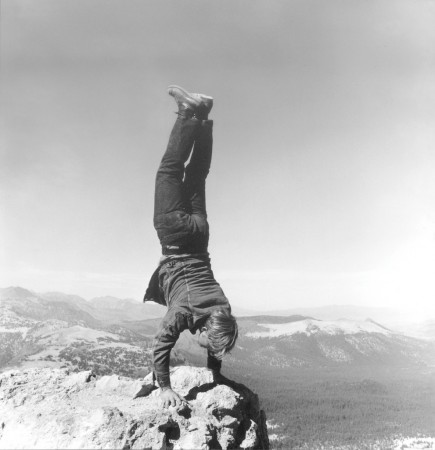Archive for the ‘Positivity’ Category
Prototype the Unfamiliar
 Today’s answer to everything is process and tools. Define the desired outcome; create the process; create the tools. Problem solved.
Today’s answer to everything is process and tools. Define the desired outcome; create the process; create the tools. Problem solved.
But if the desired outcome is lasting change, deterministic processes and static tools won’t get us there. Lasting change comes from people and their behavior.
Going forward, instead of creating process, create an environment of trust so people will investigate the unfamiliar; and instead of creating tools, create time – time for people to prototype the unfamiliar.
Choose to Choose
 There will always be more work than time – no choice there. But, you can choose your mindset. You can choose to be overwhelmed; you can complain; and you can feel bad for yourself. You can also choose to invert it – you only work on vital projects because less important ones aren’t worth your time. Inverted, work is prioritized to make best use of your valuable time. When there’s too much work you can whine and complain, or you can value yourself – your choice
There will always be more work than time – no choice there. But, you can choose your mindset. You can choose to be overwhelmed; you can complain; and you can feel bad for yourself. You can also choose to invert it – you only work on vital projects because less important ones aren’t worth your time. Inverted, work is prioritized to make best use of your valuable time. When there’s too much work you can whine and complain, or you can value yourself – your choice
Most of us don’t choose what we work on, and sometimes it’s work we’ve done before. You can choose to look at as mind numbing tedium, or you can flip it. You can look at it as an opportunity to do your work a better way; to try a more effective approach; to invent something new. With repeat work you can dull it down or try to shine – your choice.
Sometimes we’re asked to do new and challenging work. You can choose to be afraid; you can make excuses; and you can call in sick for the next month. Or you can twist it to your advantage and see it as an opportunity to stretch. With challenging work you can stunt yourself or grow – your choice.
Negativity repels and positivity attracts – it’s time for you to choose.
You might be a superhero if…
- Using just dirt, rocks, and sticks, you can bring to life a product that makes life better for society.
- Using just your mind, you can radically simplify the factory by changing the product itself.
- Using your analytical skills, you can increase product function in ways that reinvent your industry.
- Using your knowledge of physics, you can solve a longstanding manufacturing problem by making a product insensitive to variation.
- Using your knowledge of Design for Manufacturing and Assembly, you can reduce product cost by 50%.
- Using your knowledge of materials, you can eliminate a fundamental factory bottleneck by changing what the product is made from.
- Using your curiosity and creativity, you can invent and commercialize a product that creates a new industry.
- Using your superpowers, you think you can fix a country’s economy one company at a time.
Celestial Work and Gravitational Pull
 Meeting agendas are a good idea. They make clear what will happen and they’re time bound. (At least good ones.) They look forward in time and shape what will happen.
Meeting agendas are a good idea. They make clear what will happen and they’re time bound. (At least good ones.) They look forward in time and shape what will happen.
Meeting agendas are created by the organizer so others follow. It’s strange to think about, but from thin air, the organizer congers magic words on a page that shape direction. The agenda sets the agenda and it’s followed. But in truth, agendas are followed because we choose to follow.
But I want to introduce another schema – the work sets the agenda. In this parallel universe, we don’t choose to follow an agenda; we choose to do work so powerful it sets the agenda – work so dense its gravitational field pulls the organization toward it.
I can hear the moans and groans – we can’t choose the work we do. But you can – if your work is good enough. If your work is brighter than the sun, it’s undeniable and, like the sun, cannot be ignored.
I can hear the next round of moans – we can’t do work that good. But you can – if you think you can and you try. (The only way to guarantee you can’t is not to try.)
And the last round of groans – we’ll get fired if we fail. If you’ll get fired for trying to reinvent your universe, you’re working at the wrong place anyway.
If you like to follow agendas, follow them. But if you don’t, do celestial work, and set them.
Not Invented Here
 Not Invented Here (NIH) is ever-present and misunderstood.
Not Invented Here (NIH) is ever-present and misunderstood.
An operational definition of NIH: Group 1 creates new thinking that falls within the official domain of Group 2. When presented with the new thinking, Group 2 rejects it.
It is said Group 2 rejects new thinking because they’re threatened. But that’s too high level to be helpful. To get at the root of it, we need to dig.
First, some NIH:
- Your new thinking is out of alignment with my priorities. Even if I spend a lot of time to understand it, I’m afraid I’ll fail. I reject your new thinking.
- Your new thinking is out of alignment with responsibility. (That thinking should come from me.) If I adopt your new thinking, I’ll look stupid, and I’m afraid I’ll fail. I reject your new thinking.
- Your new thinking is out of alignment with my knowledge. I’m afraid I’ll fail. I reject your new thinking.
- Your new thinking is out of alignment with how I do things. I’m afraid I’ll fail. I reject your new thinking.
Now, some non-NIH :
- My priorities are out of alignment with your new thinking. Though I already have several good ideas that I don’t have time for, can you give me more details so together we can combine the best elements?
- My responsibility is out of alignment with your new thinking, but your new thinking is good. Can you give me more details so together we can investigate possibilities?
- My knowledge is out of alignment with your new thinking. Can you give me more details so we can learn together?
- My way of doing things is out of alignment with your new thinking. Can you give me more details so together we can rethink things?
The key to NIH reduction is to create alignment. With your new thinking not yet fully formed, ask Group 2 for their input. Better yet, ask for their help. Tell them what you don’t know, tell them what you have wrong, tell them how they have a better perspective because it’s their domain, and ask them to help improve it. (All this is best done informally and off-line, at least to start.)
One little-known fact about NIH – it’s pronoun sensitive. Take care to replace I, you, and yours with we.
Thoughts on Vacation
Take fewer longer vacations at the expense of shorter ones.
Work hard, but on something else.
On route to your destination, throw your cell phone from a moving vehicle.
Forget about your work so you can do it better when you return.
Don’t check in at work – that undoes all the relaxation.
Vacation with kids, and take your cues from them.
Mindset for Doing New
 The more work I do with innovation, the more I believe mindset is the most important thing. Here’s what I believe:
The more work I do with innovation, the more I believe mindset is the most important thing. Here’s what I believe:
Doing new doesn’t take a lot of time; it’s getting your mind ready that takes time.
Engineers must get over their fear of doing new.
Without a problem there can be no newness.
Problem definition is the most important part of problem solving.
If you believe it can work or it can’t, you’re right.
Activity is different from progress.
Thinking is progress.
In short, I believe state-of-the-art is limited by state-of-mind.
The Dark Art of Uncertainty
 Engineers hate uncertainty. (More precisely, it scares us to death.) And our role in the company is to snuff it out at every turn, or so we think.
Engineers hate uncertainty. (More precisely, it scares us to death.) And our role in the company is to snuff it out at every turn, or so we think.
To shield ourselves from uncertainty, we take refuge in our analyses. We create intricate computer wizardry to calm our soles. We tell ourselves our analytic powers can stand toe-to-toe with uncertainty. Though too afraid to admit, at the deepest level we know the magic of our analytics can’t dispatch uncertainty. Like He-Who-Should-Not-Should-Be-Named, uncertainty is ever-present and all-powerful. And he last thing we want is to call it by name.
Our best feint is to kill uncertainty before it festers. As soon as uncertainty is birthed, we try slay it with our guttural chant “It won’t work, it won’t work, it won’t work”. Like Dementors, we drain peace, hope, and happiness out of the air around a new idea. We suck out every good feeling and reduce it to something like itself, but soulless. We feed on it until we’re left with nothing but the worst of the idea.1
Insidiously, we conjure premonitions of mythical problems and predict off-axis maladies. And then we cast hexes on innovators when they don’t have answers to our irrelevant quandaries.
But our unnatural bias against uncertainty is misplaced. Without uncertainty there is no learning. Luckily, there are contrivances to battle the dark art of uncertainty.
When the engineering warlocks start their magic, ask them to be specific about their premonitions. Demand they define the problem narrowly – between two elements of the best embodiment; demand they describe the physical mechanisms behind the problem (warlocks are no match for physics); demand they define the problem narrowly in time – when the system spools up, when it slows down, just before it gets hot, right after it cools down. What the warlocks quickly learn is the problem is not the uncertainty around the new idea; the problem is the uncertainty of their knowledge. After several clashes with the talisman of physics, they take off their funny pointy hats, put away their wands, and start contributing in a constructive way. They’re now in the right frame of mind to obsolete their best work
Uncertainty is not bad. Denying it exists is bad, and pretending we can eliminate it is bad. It’s time to demonstrate Potter-like behavior and name what others dare not name.
Uncertainty, Uncertainty, Uncertainty.
Untapped Power of Self
 As a subject matter expert (SME), you have more power than you think, and certainly more than you demonstrate.
As a subject matter expert (SME), you have more power than you think, and certainly more than you demonstrate.
As an SME, you have special knowledge. Looking back, you know what worked, what didn’t, and why; looking forward, you know what should work, what shouldn’t, and why. There’s power in your special knowledge, but you underestimate it and don’t use it to move the needle.
As an SME, without your special knowledge there are no new products, no new technologies, and no new markets. Without it, it’s same-old, same-old until the competition outguns you. It’s time you realize your importance and behave that way.
As an SME, when you and your SME friends gang together, your company must listen. Your gang knows it all. From the system-level stuff to the most detailed detail, you know it. Remember, you invented the technology that powers your products. It’s time you behave that way.
As an SME, with your power comes responsibility – you have an obligation to use your power for good. Figure out what the technology wants, and do that; do the sustainable thing; do the thing that creates jobs; do what’s good for the economy; sit yourself in the future, look back, and do what you think is right.
As an SME, I’m calling you out. I trust you, now it’s time to trust yourself. And it’s time for you to behave that way.
The Forbidden Fruit of Failure
 We’ve mapped failure to the wrong words. And this mis-mapping is so strong and deep that un-mapping seems unlikely. I propose failure, as a word, be scratched from the dictionary.
We’ve mapped failure to the wrong words. And this mis-mapping is so strong and deep that un-mapping seems unlikely. I propose failure, as a word, be scratched from the dictionary.
Failure is learning in the form of experiments (including the thought kind) with outcomes different than theorized, where the outcomes create a more complete understanding of theory, or learning.
Wrong is mapped to failure, but failure should be mapped with – different than our best understanding.
Newness is mapped to failure. Replace failure with learning and the mapping is right – more newness, more learning. This is why tolerance of failure (and newness) is a must – no newness, no failure, no learning.
Risk is mapped to failure. Replace failure with learning and the mapping is right – more risk, more learning. Risk cannot be forbidden, if we’re to learn.
Risk and newness are mapped to late, and, guilt by association, failure is mapped to late. Replace failure with learning and the mapping is right – learn fast to avoid being late. And now, after several paragraphs of un-mapping, hopefully the re-substitution makes sense – fail fast to avoid being late.
Failure isn’t failure, failure is learning.
Of Sound Mind and Body
 As professionals we get paid to think. But unlike professional athletes, we’ve forgotten the importance of mind and body.
As professionals we get paid to think. But unlike professional athletes, we’ve forgotten the importance of mind and body.
Clearly, mind is connected to body. (I’m not talking about a metaphysical connection, I’m talking about a physical physical connection.) There are electromechanical connections (nerves) that pass information between the two and hydromechanical connections (blood vessels) that pass chemistry (oxygen and glucose, among others). The coupling is clear – what happens in one influences the other, then the other retorts. This back-and-forth ringing is complex and real. From the outside, our system architecture is highly coupled, yet from the inside we forget.
Professional athletes want high performance, and they get it through hard work, good food, regimented eating schedules, and rest. From the outside it seems they’re all about body, but on the inside they’re all whole system optimization – mind and body. (Yogi Berra – baseball is 90% mental and the other half physical.) They know food and rest influence the body, but they also know it influences the mind. They remember, we forget.
As a professional thinker, I urge you to do all you can to think well. Eat well, eat regularly, and get rest. The cost of a bad decision is high, and they’re more likely when blood sugar is low and you’re tired. If you don’t do it for your career, do it for your company – remember, they’re paying you to think.
(Image credit: iStockphoto)


 Mike Shipulski
Mike Shipulski